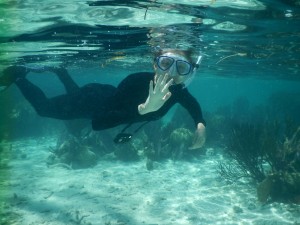Today we took a boat out to snorkel a little farther from the station. We visited two patch reefs, one in the Marine Protected Area and one outside of it. At each reef, we measured stony coral and macroalgae cover to learn about the reef’s health. In addition, we collected sea urchins at each site, to learn about their relative size and abundance. Urchins are important for reefs because they feed on macroalgae, but they also bore into stony corals. If they become too abundant they can do more harm than good and fragment the reef framework.
We haven’t finished our data analysis yet, but some differences were immediately apparent. The stony corals in the marine protected area were much larger and denser, and the sandy patches between corals were often bare. In the unprotected area, large stony corals more spread out and the reef was dominated by soft corals. Most of the area we surveyed was sand rather than reef. These areas were full of sea grass and red algae, contrasting sharply with the open areas of the protected reef. I still haven’t seen a tunicate, but I saw several species of red algae. The most common, tubular thicket algae and Amphiroa fragilissima, covered the sea floor in the unprotected area.
This evening we put a light out under the dock, hoping to attract some interesting species. We only attracted minnows and shrimp, so eventually we turned off the light and looked at the stars instead. Lying on our backs, watching shooting stars, was easily my favorite part of today. We usually keep pretty busy, and it was so nice to have the chance to step back and fully appreciate this beautiful place in which we live.





















